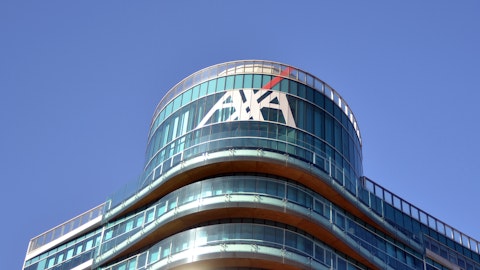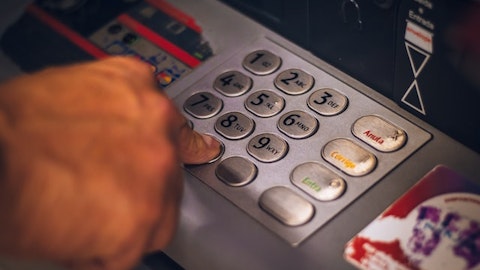First Hawaiian, Inc. (NASDAQ:FHB) Q3 2023 Earnings Call Transcript October 27, 2023
Operator: Good day and thank you for standing by. Welcome to the First Hawaiian, Inc. Q3 Earnings Conference Call. At this time, all participants are in a listen-only mode. After the speakers’ presentation, there’ll be a question-and-answer session. [Operator Instructions] Please be advised, today’s conference is being recorded. I would now like to hand the conference over to your speaker today, Kevin Haseyama, Investor Relations Manager. Please go ahead.
Kevin Haseyama: Thank you, Kevin, and thank you everyone for joining us as we review our financial results for the third quarter of 2023. With me today are Bob Harrison, Chairman, President and CEO; Jamie Moses, Chief Financial Officer; and Lea Nakamura, Chief Risk Officer. We have prepared a slide presentation that we will refer to in our remarks today. The presentation is available for downloading and viewing on our website at fhb.com in the Investor Relations section. During today’s call, we will be making forward-looking statements, so please refer to slide one, for our Safe Harbor statement. We may also discuss certain non-GAAP financial measures. The appendix to this presentation contains reconciliations of these non-GAAP financial measures to the most directly comparable GAAP measurements. And now I will turn the call over to Bob.
Robert Harrison: Good morning, everybody. Thank you, Kevin. Before we get started, I just want to say a few words about what happened in Maui and the tragedy of the fires there on August 8th saddens all of us to see the loss of life and just the destruction that happened. I want to say thank you to our employees, who were out there to support our customers and the community and everybody there, it’s a very difficult situation. It’s something we’ll have to work through as a community over the next several years. But the good news is our employees and retirees are safe. A number of them did lose their homes, and certainly, we’re outreaching to them to see how we can help. Our Lahaina branch was destroyed in the fire. We were able to recover without any damage, all of our customer safe deposit boxes, and we’re able to return them to them.
And going out there a few times to meet with our customers and the community and most importantly, our employees, it really gives me a lot of hope that we can do this and do this in a way that builds we’ll hand it back in a way that we’re all comfortable with and proud of. So and finally, on that note, I just wanted to say thank you to all of our friends and family and vendors, investors around the world literally that reached out to express their condolences and see how they could help if there is anything they could do. Thank you for that. Also to start with an overview of the local economy. Hawaii economy actually remains strong. It is too early to really determine the impact of the fires on the economy of Maui or the State of Hawaii, but we do expect over time the rebuilding activity will spur economic stimulus for that area and along with an eventual return of visitors.
The Mayor has declared that Maui will be fully open on November 1st. We don’t think that will happen overnight. We think there will be a slower return of tourists to Maui over time. State-wide seasonally adjusted unemployment rate in September was 2.8% compared to the national unemployment rate of 3.8%. So some good news there. The visitor industry performed well on a year-to-date basis. Through August, total visitor arrivals were up 8% over the previous year and total spend was 10% higher. Even more encouraging is the increase in arrivals from Japan with year-to-date arrivals of 331,000 visitors, significantly higher than the prior year. However, we did see a downturn in arrivals after the Maui fires on August 8th. The total visitor arrivals in August were 7% below August of 2022 and visitor spend was 9% below August of 2022.
The housing market has remained stable in spite of higher interest rates and reduced activity. Median sales price for a single-family home on Oahu in September was $1.1 million, 4.5% below last September. The median sales price for condominiums on Oahu was $533,000, 6% higher than the previous year. Turning to slide two, I’ll provide some highlights of our solid third quarter financial performance. Net income was $58.2 million, $0.46 per share as we grew retail and commercial deposits. We continue to grow capital and credit quality remained excellent. Our return on average assets was 0.97% and return on average tangible common equity was 16.84%. We continue to maintain strong capital levels with a CET1 ratio of 12.2% and total capital ratio of 13.38% at quarter end.
Turning to slide three. Our balance sheet remains solid. Cash and cash equivalents were slightly elevated at the end of the quarter as we had anticipated an outflow from our public deposit accounts. The average balance of cash and cash equivalents in the quarter was $885 million. The $500 million of short-term borrowings at the end of the quarter was not new, but it was a transition and classification of the existing borrowing as a move to less than 12 months maturity. We continue to have strong liquidity. As of September 30th, our total available liquidity was $8.3 billion, which was 100% of uninsured non-public deposits. The investment portfolio continued to perform consistently through the volatile interest rate environment. The duration remains stable at 5.5 years and cash flows from the portfolio around about $69 million per month as expected.

Turning to slide four. Period-end loans and leases were $14.4 billion, about $30 million lower than Q2. We had good growth in CRE loans, primarily driven by $150 million of completed construction loans that converted to CRE. And then the paydowns in the construction loans were largely offset by draws on ongoing projects. The decline in C&I balances was due to a combination of a decrease in dealer floor plan balances, seasonal line payoffs and other loan payoffs. Looking forward, additional paydowns from completed construction projects will cause loan balances to be relatively flat in the fourth quarter. As a result, full year loan growth will be about 1%. Now I’ll turn it over to Jamie.
James Moses: Thank you, Bob, and good morning, everyone. Turning to slide five. Our deposit base continues to show its strength as we grew balances in the third quarter. Deposits totaled $21.5 billion, which was a linked quarter increase of $433 million or 2.1%. The increase was driven by increases in retail, commercial and public operating deposits. Retail and commercial deposits increased by $332 million, with commercial deposits up $238 million and retail increasing by $94 million. Public deposit balances increased by $102 million in the quarter, with operating balances growing by $129 million, which was partially offset by a $28 million decline in higher-cost public time deposits. The ratio of noninterest-bearing deposits to total deposits was 36.7%, which gets us back to roughly the 36% level we were at pre-COVID.
Our total cost of deposits was 140 basis points in the third quarter, a 29 basis point increase from the prior quarter due to higher rates paid and the continued shift in mix to higher rate deposit accounts. Turning to slide six. Net interest income declined by $2.8 million from the prior quarter to $157.1 million. The decrease was primarily due to higher funding costs partially offset by higher asset yields. The net interest margin declined by five basis points to 2.86%. The decline in margin was much less than the forecast we shared last quarter and was a direct result of the stabilization in deposit balances in the third quarter, enabling us to pay down higher cost public time deposits and relieve some of the deposit cost pressure. We anticipate that the NIM will trough in the mid-270 range sometime in the fourth quarter.
Through the end of the third quarter, the cumulative betas were 40.7% on interest-bearing deposits and 25.5% on total deposits. Turning to slide seven. Noninterest income was $46.1 million this quarter, a $1.3 million decline from the prior quarter. This decline was primarily due to lower BOLI income due to the higher interest rates. Expenses were $119.4 million, $1.5 million lower than the prior quarter. The third quarter included approximately $600,000 of expenses related to the Maui wildfires and typhoon that struck Guam as well as $250,000 donation to the Maui Strong Fund. Now I’ll turn it over to Lea.
Lea Nakamura: Thank you, Jamie. Moving to slide eight. The bank maintained its strong credit performance and healthy credit metrics in the third quarter. Commercial criticized assets ticked up to 1.07% of total loans and leases driven primarily by a single credit downgraded to special mention. Classified assets fell 20 basis points to 0.21% of total loans and leases, primarily due to the payoff of a single loan. Year-to-date net charge-offs were $6.5 million. Our annualized year-to-date net charge-off rate was six basis points, four basis points lower than in the second quarter. Nonperforming assets and 90-day past due loans were 13 basis points at the end of the third quarter, up two basis points from the prior quarter. And lastly the bank recorded a $7.5 million provision for the quarter.
Moving to slide nine. We show our third quarter allowance for credit losses broken out by disclosure segments. The asset ACL increased by $6.2 million to $154.8 million, with coverage rising five basis points to 1.08% of total loans and leases. The increase this quarter is due primarily to the estimated potential impact of the Maui wildfires. We’ve included a slide in the appendix that summarizes our Maui lending exposure. While it’s too soon to assess the long-term economic impact that the fires will have on Maui, our preliminary estimate of the potential loss related to the fires is $9.1 million. This estimate includes the potential impact to borrowers located both inside and outside of the fire zones as well as any insurance coverage. Turning to slide 10.
We provide an updated snapshot of our commercial real estate exposure. CRE represents approximately 30% of total loans and leases. Credit quality remains strong with LTVs manageable and criticized loans comprising, excuse me, continuing to comprise a very small portion of the portfolio. Criticized office CRE fell from 5.8% last quarter to 1.7% at the end of the third quarter. This decrease was due primarily to the previously mentioned loan payoff. This loan was our only office property in Downtown Los Angeles. Let me now turn the call back to Bob for any closing remarks.
Robert Harrison: Thank you, Jamie and Lea. That concludes our prepared remarks. We’d be happy to take any of your questions.
See also 12 Best Places to Retire in Netherlands and 15 Best Cloud Computing Stocks Heading into 2024.
Q&A Session
Follow First Hawaiian Inc. (NASDAQ:FHB)
Follow First Hawaiian Inc. (NASDAQ:FHB)
Receive real-time insider trading and news alerts
Operator: Thank you. [Operator Instructions] Our first question comes from Andrew Liesch with Piper Sandler. Your line is open.
Andrew Liesch: Hey, good morning, everyone.
Robert Harrison: Good morning, Andrew.
James Moses: Good morning.
Andrew Liesch: Jamie, on the margin guide, mid-270s. So it looks like that the pace of compression is going to pick up here in the fourth quarter. I guess, what’s driving that?
James Moses: Well, we still have some deposit mix shift that’s happening. And we’re still just kind of thinking through all of the — all the dynamics of the balance sheet that are going to drive the NIM guide. So I think we have that continued mix shift from noninterest-bearing to interest-bearing. And we have some things happen in the third quarter that went our way that we’re not expecting that they’re going to continue to go our way in terms of the NIM for the fourth quarter. And just to give more color on that, Andrew, the September spot NIM was $2.79.
Andrew Liesch: Okay. All right. That’s helpful then. Good jump on — just a question on the criticized loans. It sounds like just one new one that came in this quarter. But if you look at the entire book of criticized, is there anything consistent, any themes amongst all of the loans that are in that portfolio?
Robert Harrison: Andrew, maybe I’ll start. This is Bob and I’ll hand it off to Lea. We’ve just had very good loan quality and one of the results of that is that there’s one or two loans that go one way or the other. It moves the needle on the percentages. So there’s nothing out there that we’re concerned about. We had talked in last quarter on the call about a couple of office loans. One of those was paid off. And that was a nice result for us, paid off in full, but nothing that I’m seeing. Lea?
Lea Nakamura: No, I don’t really have anything to add other than that particular loan. As with the other loans we’ve talked about before, they are really strong sponsors, and we’re very comfortable and they continue to perform actually. So we’re actually quite comfortable.
Andrew Liesch: Got it. All right. Thank you for taking the questions. I’ll step back.
Operator: [Operator Instructions] One moment for our next question. Our next question comes from Kelly Motta with KBW. Your line is open.
Kelly Motta: Hi. Thanks so much for the question. I was hoping to dig a little bit more into the moving pieces of margin. It looks like your loan yields still went up really nicely. Just wondering, provided that the Fed is done hiking here, and I know that’s a big assumption, what — how much of your loans still continue to reprice kind of like on a quarter-over-quarter basis, assuming no rate changes, because I know a lot of your loans are floating rate?
James Moses: Right. So thanks, Kelly. Good morning to you as well. So we have about $5.2 billion in loans that are floating rate, so we’ll kind of reprice pretty consistently. And then you add into that, our fixed rate cash flows kind of over a 12-month period, you can think about that as like another $1.5 billion on average that would reprice throughout the year. So — assuming balances were flat. So I think it’s a pretty big number in terms of our balances on the balance sheet that will reprice. Again, right, assuming rates stay flat, those will all reprice to the higher market rates today.



